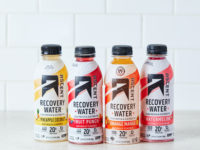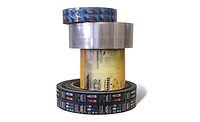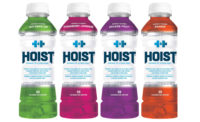When the fairy godmother in Walt Disney’s version of “Cinderella” dressed the maiden for the ball, she made sure that everything fit perfectly — including that ever-important glass slipper. Although beverage-makers don’t have the benefit of calling upon a fairy godmother for their labeling needs, advancements and innovations offer more opportunities for labels to fit as perfectly as Cinderella’s glass slipper.
In the Packaging Machinery Manufacturers Institute’s (PMMI) 2012 report titled “Trends in Labeling,” the Reston, Va.-based company states: “One of the most dynamic and fast-changing elements of product packaging, labels not only reflect the product manufacturer’s brand, they differentiate product packaging and provide consumers with an abundance of information about the product itself.”
One of the ways brand owners are addressing this trend is through the use of shrink-sleeve materials.
“Shrink sleeves help beverages differentiate themselves on the shelf by combining shape and color for 360-degree, eye-catching beverage packages,” says Gwen Chapdelaine, marketing director for Fort Dearborn, Elk Grove, Ill. “This combination creates product distinction and visual appeal not achievable with other label formats.”
On the other hand, many beverage-makers have turned to stretch-sleeve technology for their labeling needs.
“On the stretch side, the newest trend is the high-elasticity [polyethylene] (PE) material able to follow bottle shapes at a fraction of the cost of shrink sleeves, as well as non-heat multi-packing used for convenience and warehouse stores,” says Alcyr Coelho, vice president of sales and marketing for PDC Europe – Americas, Austin, Texas.
According to PMMI’s report, pressure-sensitive labels remain the most popular type of label, and a majority of manufacturers interviewed for the report intend to continue using them; however, the dominant label material could face increased competition from label types such as heat shrink, stretch-sleeve, in-mold and other labeling methods.
Although the report states that stretch-sleeve and heat-shrink usage is increasing, their share of the market varies based on two reporting methods, it explains. Citing a Freedonia study, some experts estimate that 7 percent of the market share was occupied by stretch-sleeve and heat-shrink labels in 2012. However, product manufacturers interviewed for PMMI’s report state that they are using a larger percentage of this technology, with 18 percent reporting usage in 2012.
PMMI’s report also found that 35 percent of manufacturers interviewed currently use heat-shrink and stretch-sleeve labels, and that nearly half of that group plans to increase the usage of that technology.
Citing its product differentiation advantages, the report predicts a bright future for the product-conforming labeling technology.
“Increased adoption of shrink-sleeve labels are likely to grow at the expense of pressure-sensitive labels as well as other label types and are also being used frequently for new product introductions,” the report states.
Full of advantages
In PMMI’s report, the association cited four key benefits to using shrink sleeves: conforms to irregularly shaped containers; offers a 360-degree surface to print required label content; allows for innovative and color graphics for product differentiation; and provides a tamper-evident seal around the lid of the container.
Suppliers also echo these advantages when describing the advantages shrink- and stretch-sleeve technology can offer to beverage-makers.
“Shrink sleeves [are] the only labeling system able to successfully provide full coverage of most bottle shapes developed by marketers,” PDC’s Coelho says. “Many other systems have been introduced trying to challenge this unique quality of shrink sleeves, but none have been able to match the ease of application with consistent performance.”
Noting some of its conforming limitations, Coelho adds that stretch sleeves can be a cost-effective complement to shrink sleeves.
“The new high-elasticity PE stretch sleeves can provide full coverage on shapes with up to 55 percent shrink ratio, using the same simple, non-glue, tubing sleeve format of shrink sleeves but without the need of a shrink tunnel, and at a lower cost — 30 to 50 percent [less] — than shrink sleeves,” he explains. “However, stretch sleeves cannot be used on applications where tamper-evident capability is necessary.”
Don Earl, president of Overnight Labels, Deer Park, N.Y., notes that shrink sleeves also can add the benefit of durability and scuff resistance; however, he highlights the number of material options as one of its key advantage points.
“Shrink [sleeves have] a number of options where you can use [polylactic acid] (PLA), which is a compostable material; you can use [polyethylene terephthalate glycol] (PETG), which is a highly recyclable material [and] generally is the same type of material as a bottle, which makes much more sense for the recycling stream when you have similar materials throughout the package,” he says. “You can take the bottle, a PETG bottle, and a PETG label and just throw the whole bottle in the [recycling bin], and it’s completely recyclable of itself than let’s say [having] a paper label on a glass bottle [where] the paper label has to come off the bottle, so this way you have a clean glass bottle going into the recycling stream.”
Keeping options open
As beverage manufacturers develop more unique bottle shapes, suppliers want to make sure they can offer brand owners different material and printing options to meet this shapely market.
SleeveSeal, Little Rock, Ark., offers a variety of shrink-sleeve materials including PETG, oriented polystyrene sheet (OPS) and polyvinyl chloride (PVC).
“Trends we are seeing in the beverage industry are different uses of inks with shrink labels,” says Jyl Barnett, marketing manager with SleeveCo, Dawsonville, Ga. “For example, one that we are seeing more and more of is registered matte finishes that highlight certain design elements. With stretch labels, we are seeing more interest in the super-stretch material. This is basically a cross between a shrink label and a stretch label. The material has characteristics of a stretch label but accommodates the containers that have some contour.”
Although the substrate is fairly new to U.S. customers, Barnett foresees its popularity increasing as time goes on.
“The super-stretch is newer to the U.S., but I can see this becoming a more prevalent label method, especially in the beverage market, with its material benefits and allowing for some curve design in the bottle,” Barnett explains.
SleeveCo also offers a comprehensive, DuPont-certified, in-house graphics prepress department that features a staff with expert knowledge about graphics setup, inks, cylinders/plates and printing permits that are used to direct a customer’s vision and maximize its impact on the label, Barnett says.
Offering a variety of inks, coatings, printing capabilities and substrates, Fort Dearborn also offers its customers a number of options and assists in selecting what is best for its clients.
“For substrates, we offer PVC, PETG and high-yield PETG white film, OPS and EarthFirst PLA films,” Chapdelaine says. “Each film has its own advantages and disadvantages regarding shrink percentage, recyclability, etc. Our technical services group works with customers to ensure that [the] appropriate film is chosen to meet their needs and application requirements.”
Making your mark
In order to supply customers with quality shrink- and stretch-sleeve labels, suppliers are investing in inks and printing options to match the quality of its substrates.
Adding to its dedication to “next-generation packaging,” Chapdelaine says Fort Dearborn offers specialty inks and coatings such as metallic fluorescent, holographic, color-shifting, glow-in-the-dark, thermochromatic and pearlescent inks, as well as matte acid etch, scented, soft-touch and tactile-feel coatings.
“These specialty inks and coatings help differentiate a product, especially a beverage product, since many beverage products are currently utilizing shrink sleeves,” she says.
The company also offers different print technologies including ultraviolet (UV) and water-based flexographic, rotogravure and digital for proto-typing, sales samples and short runs. “This affords customers print flexibility to meet their production volume requirements,” Chapdelaine explains.
Hammer Packaging, West Henrietta, N.Y., echoes the importance of high-quality graphics for a variety of customers. The company features a vast portfolio of variable sleeve offset printing (VSOP) Web press technology for sleeves.
“That means the highest quality graphic with no plate or cylinder charges,” says Lou Iovoli, vice president of strategic partnerships and marketing for Hammer Packaging. “We can run combinations across the Web or high-volume dedicated runs.”
Iovoli adds that the company works with a variety of styles for ink and coating systems such as cold-foil stamping, metalized inks and unique coatings.
“We’re always looking to create the next great way to help a client market themselves better and sell more,” he says.
Because of all of the options out there, suppliers are investing their capital to meet the needs of brand owners. Overnight Labels recently purchased and is in the process of installing a 22-inch, 10-color printing press. This new, all-UV press will allow Overnight Labels to provide its customers with shrink sleeves with a layflat of up to 275 mm, the company says.
Earl notes that the flexographic printer is able to print on virtually any substrate. “It gives the customer a lot of flexibility, because we can add different decorations in-line, we can add foil in-line, [and] we can add a matte finish in-line,” he says. “We can use a bunch of different types of inks on substrates, which give the customer a lot more flexibility.”
Because Overnight Labels uses a Web-based press instead of gravure cylinders, its entry fee is financially accommodating for new product introductions, Earl says.
MRI Flexible Packaging also has invested to expand its capabilities with its C-Fit higher elastic stretch films, which can be used for single-serve bottles. The new films are an alternative to shrink sleeves, says Jim Mallon, vice president of sales and marketing for the Newtown, Pa.-based company.
C-Fit is a heatless shrink-sleeve labeling solution developed in partnership with MRI Flexible and PDC Europe – Americas, according to MRI Flexible’s website.
MRI Flexible also invested in a new pre-press, Kodak Hi-Def, and a new press, Bobst F&K 20SIX. The press is equipped with higher line screen printing (175 dpi), a seven-color expanded gamut, 51-inch Web width, quick changeovers and smart global positioning system automatic registration technology.
“The new 20SIX press for shrink-sleeve labels is going to increase our productivity five-fold,” the company said in a statement. “With it, we will be able to get jobs through the press quicker, [and] we can do backside printing now with a full 10 colors on the reverse side. Our core business customers have a lot of SKUs — 30, 40, 50, 60 jobs — and this press will allow us in and out of those jobs much quicker. We added the 20SIX press because we were looking for something that gives us a competitive edge in the short-run market; we want something that obviously runs at a faster speed. We wanted something that has the ability to change over very quickly.”
Lighter future
Although package lightweighting is a recognizable trend within the beverage industry, the trend also could be influencing the label market. According to PMMI’s report, 43 percent of manufacturers interviewed are reducing label material thickness or minimizing label waste.
“However, thinner label film is more susceptible to stress during a high-speed product run, and therefore breakage,” the report states.
To meet these demands, suppliers are working to offer solutions. Hammer Packaging recently worked with a sleeve applicator company to seam and sleeve using 30-micron material.
“As new equipment is introduced to the market, the demand for lighter-weight material will increase,” Mallon says.
Fort Dearborn’s Chapdelaine also sees lightweighting and other trends emerging. “We see demand for additional functionality — development or barrier sleeves to allow for shelf-life extension or lightweighting of containers — and sustainability options [with] the development of more eco-friendly and lower-density films within the technology.” BI






